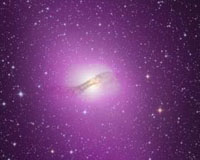 |
Washington DC (SPX) Aug 24, 2010 Using the Large Area Telescope (LAT) onboard NASA's Fermi Gamma-ray Space Telescope satellite, astronomers have detected gamma rays from a nova for the first time, a finding that surprises both observers and theorists. The discovery dispels the long-held idea that nova explosions are not powerful enough to produce such high-energy radiation. These findings are published in Science with Teddy Cheung, an astrophysicist at the Naval Research Laboratory, as the lead author. A nova is a sudden, rapid increase in the brightness of a star. The explosion occurs when a white dwarf ignites in an enormous thermonuclear explosion. The newly detected explosion is equivalent to about 1,000 times the energy that the sun gives off every year. However, compared to what Fermi is capable of detecting, this exploding nova is a relatively modest event. Gamma rays are the most energetic form of light, and scientists believe the observed gamma-ray emission arises as a million-mile-per-hour shock wave races from the site of the explosion. Fermi's LAT detected the nova for 15 days. The nova explosion was first noticed on March 11, when amateur astronomers Koichi Nishiyama and Fujio Kabashima in Miyaki-cho, Saga Prefecture, imaged a dramatic change in the brightness of a star in the constellation Cygnus. They knew that the star, known as V407 Cyg, was 10 times brighter than it appeared in an image they had taken three days earlier. The amateur astronomers contacted Hiroyuki Maehara at Kyoto University, who in turn notified astronomers around the world asking for follow-up observations. "A few days later, automatic processing of data from Fermi's LAT alerted us to a new high-energy gamma-ray source at the same location as the nova," said NRL's Cheung. "When we looked closer, we found that the LAT had detected the first gamma rays at about the same time as the nova's discovery." The white dwarf star V407 Cyg lies 9,000 light-years away in the plane of our Milky Way galaxy. The system contains a compact white dwarf and a red giant star about 500 times the size of the sun. The red giant star's outermost atmosphere is leaking away into space in a manner similar to the solar wind produced by the sun, but with a stronger flow. The white dwarf star captures some of this gas, which accumulates on the surface of the star. With the passage of time, the gas eventually becomes hot and dense enough to fuse into helium. This energy-producing process triggers a runaway reaction that explodes the accumulated gas. The white dwarf itself, however, remains intact. The explosion creates a hot, dense, expanding shell called a shock front, composed of high-speed particles, ionized gas and magnetic fields. The spectra obtained by ground-based optical telescopes from this explosion reveal that the shock wave expanded at 7 million miles per hour - or nearly 1 percent the speed of light. The magnetic fields trap particles within the shell and whip them up to tremendous energies. Before they can escape, the particles reach velocities near the speed of light. Scientists say that the gamma rays likely result when these accelerated particles smashed into the red giant's wind. "We know that the remnants of much more powerful supernova explosions can trap and accelerate particles like this, but no one suspected that the magnetic fields in novae were strong enough to do it as well," said NRL's Soebur Razzaque. Supernova remnants endure for 100,000 years and produce radiations that affect regions of space thousands of light-years across. NRL's Kent Wood compares astronomical studies of supernova remnants to looking at images in a photo album. "It takes thousands of years for supernova remnants to evolve, but with this nova we've watched the same kinds of changes over just a few days," he said. "We've gone from a photo album to a time-lapse movie." The calorimeter subsystem of the Fermi LAT was developed at NRL and the environmental testing of both the LAT and the full Fermi observatory was conducted at NRL under the guidance of LAT Co-Principal Investigator Dr. W. Neil Johnson and LAT Commissioner Dr. J. Eric Grove, both NRL astrophysicists. The LAT project is funded in the United States by NASA and the Department of Energy in collaboration with academic institutions and government agencies in France, Italy, Japan, and Sweden.
Share This Article With Planet Earth
Related Links Fermi Gamma-ray Space Telescope Stellar Chemistry, The Universe And All Within It
 Clues To Origin Of Mysterious Dark Gamma-Ray Bursts
Clues To Origin Of Mysterious Dark Gamma-Ray BurstsKyoto, Japan (SPX) Jul 23, 2010 A research team led by astronomers from Kyoto University, Tokyo Institute of Technology, and the National Astronomical Observatory of Japan used the Subaru Telescope to observe a dark gamma-ray burst (GRB) that provides clues for understanding the origin of dark gamma-ray bursts. Their research is a very rare case of the detection of a dark GRB's host galaxy and afterglow in the near-infra ... read more |
|
| The content herein, unless otherwise known to be public domain, are Copyright 1995-2010 - SpaceDaily. AFP and UPI Wire Stories are copyright Agence France-Presse and United Press International. ESA Portal Reports are copyright European Space Agency. All NASA sourced material is public domain. Additional copyrights may apply in whole or part to other bona fide parties. Advertising does not imply endorsement,agreement or approval of any opinions, statements or information provided by SpaceDaily on any Web page published or hosted by SpaceDaily. Privacy Statement |